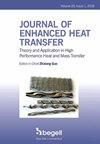EXPERIMENTAL AND THEORETICAL CHARACTERIZATION OF TWO-PHASE FLOW DISTRIBUTION IN UNBALANCED FLOW NETWORKS
IF 1.5
4区 工程技术
Q3 ENGINEERING, MECHANICAL
引用次数: 0
Abstract
This study investigates two-phase flow distribution of R-1234yf into two-branched channels. Especially, the effect of unbalanced pressure drop and tube diameter on the flow distribution was characterized and modeled. The experiments were conducted for a mass flux ranging from 393 to 1179 kg/m2s and the inlet quality was fixed at 0.2. The flow distribution was mainly governed by the pressure drop ratio between two branched channels. The mal-distribution under the unbalanced pressure drop condition was mitigated by increasing mass flux, whereas sustained mal-distribution was observed under unbalanced tube diameter conditions. Correspondingly, a theoretical representation of the phenomenon, based on the principle of minimum entropy production, was developed and adopted to predict two-phase flow distribution in an unbalanced flow network. The characteristics of the experimental data were clearly and quantitatively reflected in the prediction results. Under the unbalanced pressure drop condition, the predictions agreed well with the experimental data maintaining the maximum deviation within ±30%, whereas it exceeded ± 30% under the unbalanced tube diameter condition. The analysis of such theoretical formulation suggested the necessity of appropriate pressure drop models of flow impact, contraction, and merging at the outlet channel, that are compatible with the extremization of entropy production for further improving the prediction accuracy without compromising its generality.不平衡流网络中两相流分布的实验和理论特征
本研究探讨了 R-1234yf 在双分支通道中的两相流分布。特别是对不平衡压降和管径对流动分布的影响进行了表征和建模。实验的质量流量范围为 393 至 1179 kg/m2s,入口质量固定为 0.2。流量分布主要受两个分支通道之间的压降比影响。在不平衡压降条件下,增加质量通量可减轻不良分布,而在不平衡管径条件下,可观察到持续的不良分布。相应地,根据最小熵产生原理,建立并采用了该现象的理论表示方法,以预测不平衡流网中的两相流分布。实验数据的特征在预测结果中得到了清晰而定量的反映。在不平衡压降条件下,预测结果与实验数据吻合良好,最大偏差保持在 ±30% 以内,而在不平衡管径条件下,偏差超过 ±30%。对这种理论公式的分析表明,有必要在出口通道处建立与熵产生极端化相适应的流体冲击、收缩和合并的适当压力降模型,以进一步提高预测精度,同时不影响其通用性。
本文章由计算机程序翻译,如有差异,请以英文原文为准。
求助全文
约1分钟内获得全文
求助全文
来源期刊

Journal of Enhanced Heat Transfer
工程技术-工程:机械
CiteScore
3.60
自引率
8.70%
发文量
51
审稿时长
12 months
期刊介绍:
The Journal of Enhanced Heat Transfer will consider a wide range of scholarly papers related to the subject of "enhanced heat and mass transfer" in natural and forced convection of liquids and gases, boiling, condensation, radiative heat transfer.
Areas of interest include:
■Specially configured surface geometries, electric or magnetic fields, and fluid additives - all aimed at enhancing heat transfer rates. Papers may include theoretical modeling, experimental techniques, experimental data, and/or application of enhanced heat transfer technology.
■The general topic of "high performance" heat transfer concepts or systems is also encouraged.
 求助内容:
求助内容: 应助结果提醒方式:
应助结果提醒方式:


